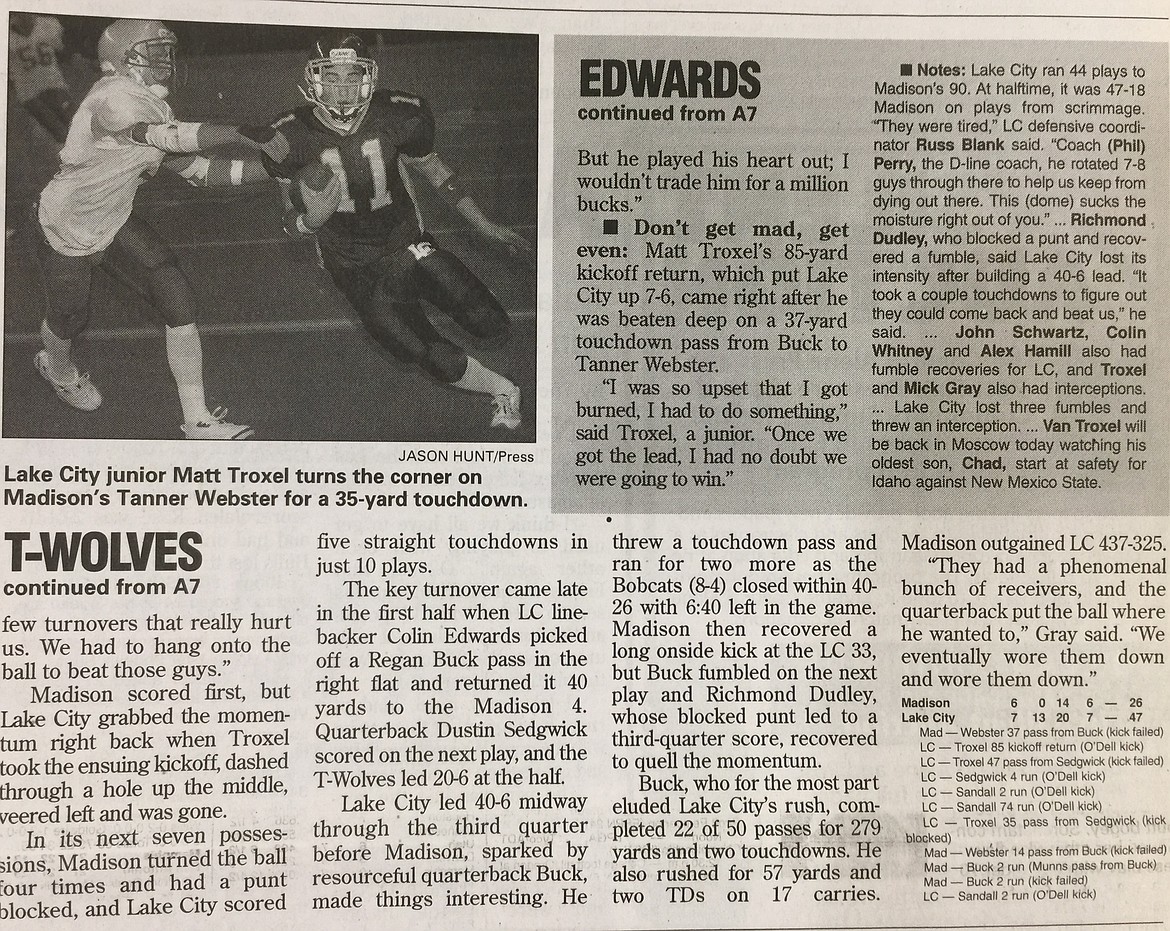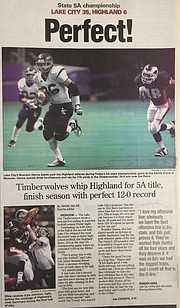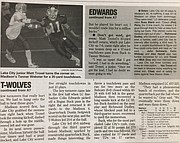HOW THEY WERE BUILT: Lake City High football — Experienced coaches, weight training, and lots of players
Coming off its first state championship in football in 2002, the school’s growing enrollment meant Lake City High had to move up to the 5A classification — one which included the largest schools in the state — the following school year.
History has shown several schools in Idaho that had dominated in one division, then were unable to repeat that success once they moved up a level.
But Lake City made a fairly seamless transition to the move up in classification. And just four years later, the Timberwolves won a state 5A football title with a dominating squad which ranks among the best in all of Idaho high school football history.
“We didn’t ever feel like it was a big step up,” said Van Troxel, who started the Lake City program in 1994, and coached the Timberwolves for 22 seasons before resigning following the 2015 season. “Because, traditionally we had played everybody. Even when we were in 4A, we played Kamiakin and Kennewick and some Boise schools, and did all that all the way through. Going back to the first year we opened up, we played Borah. So we had a tradition that we would play anybody, anywhere.”
All told, the Timberwolves made the playoffs 17 times in Troxel’s 22 seasons, including 16 straight playoff appearances from 1997-2012. In addition to the two state titles in 2002 and ’06, Lake City played in the title game two other times under Troxel, and reached the state semifinals 10 times. Of their six losses in the semis, four came at the hands of the eventual state champion.
The same year Troxel took over at Lake City, Satini Puailoa III was named head football coach at Sandpoint High. The two became fast friends, and worked together to make both programs better.
Puailoa guided the Bulldogs to a state 4A title in 1997, along the way beating Lake City in a quarterfinal game that marked the Timberwolves’ first playoff appearance in school history. Lake City reached the state semifinals in 1998, played for the state title in 1999 and 2001, and finally broke through in ’02.
“What we had done from the very start, us and Sandpoint, was built programs that were comparable to any in the state of Idaho,” Troxel said. “It was based on participation, it was based on the weight room. What us and Sandpoint did in the ’90s, building up to this point, we put ourselves in a position where we could play with anybody in the state. The amount of time we put into kids, and kids put into the weight room, and going to camps ... our program was equal to anybody in the state.”
AFTER LOSING at Eagle in the state semifinals in 1998, Lake City avenged that defeat the following year, beating the heavily favored Mustangs in the 1999 semifinals at home — in the rain and the mud.
The Timberwolves rolled into Moscow the next week for the state title game in what was then called A-1 Division II, undefeated and full of confidence.
Maybe too much confidence. Vallivue of Caldwell routed Lake City 44-7 in the title game at the Kibbie Dome.
“We had just beat the best team in the state, and you learn, kids and coaches, you learn that it doesn’t matter what happened the week before, it’s what you do the day of the game,” Troxel recalled. “And Vallivue thumped us. It was a shocker.”
Two years later, Lake City was back in the title game, this time at Holt Arena in Pocatello (and in the division called 4A). But Century High, located just 6 miles from Holt Arena, made the big plays in the second half and defeated the T-Wolves 23-12.
“It was just part of the process,” Troxel said of those losses.
In 2002, led by Matt Troxel, Van’s son, along with Alex Hamill and quarterback Dustin Sedgwick, Lake City went 9-3, beating Madison of Rexburg 47-26 at the Kibbie Dome for the T-Wolves’ first state title.
“This was a group with Sedgwick, and Matt was a junior, and Colin Edwards, Terry Jess ... they just got better and better every game,” Troxel said.
One of Lake City’s losses that season was a 38-13 thumping by Puailoa’s Sandpoint Bulldogs, at Lake City in the eighth game of the season.
The T-Wolves didn’t lose again.
Lake City, Coeur d’Alene and Sandpoint finished in a 3-way tie for the league title, and a Kansas tiebreaker determined the league’s two playoff teams.
Lake City beat Sandpoint to win the tiebreaker and earned the league’s No. 1 seed to the playoffs, and Sandpoint then beat Coeur d’Alene for the No. 2 seed. That meant Lake City played at home in the first round, and Sandpoint had to travel to southern Idaho. The Bulldogs did win, but had to play at Lake City the following week in the semis, and the T-Wolves prevailed 28-14 over the travel-weary Bulldogs.
“We stopped ’em a foot from the goal line, and we ended up being the No. 1 seed,” Troxel said of the tiebreaker. “When you look back at your program history, those are things that change the history.”
In 2003, Lake City’s first season in 5A, the Timberwolves lost at eventual state champion Centennial in the semifinals. The following year, Lake City lost in the first round to Coeur d’Alene, which reached the state title game for the first time under coach Shawn Amos. In 2005, Lake City lost at eventual champion Meridian 42-21 in the state semifinals.
That set the stage for Lake City’s group that went 12-0 in 2006, and manhandled Highland of Pocatello 35-6 in the state title game at the Kibbie Dome.
“I think they lost one game as a freshman group,” Troxel said of that year’s seniors. “They went undefeated as sophomores, half of the starters were juniors on a good team that made it to the semifinals, so we knew all the way along that it was pretty talented.”
Garren Hammons was the quarterback of that group, part of a line of talented QBs at Lake City which started with Van’s son, Chad, and continued with Jake Freeman, Matt Stern, Sedgwick, Ben Widmyer and then Hammons.
Byron Hout, then a junior, was a force on defense, and sometimes on offense when the situation called for it. The team also featured a pair of future Oregon Ducks in offensive lineman Carson York and linebacker/running back Brandon Hanna.
“We had a couple exceptional defensive tackles in (Cory) Tanner and (Brandon) Lopez,” Troxel said. “And that linebacker crew, with (Chris) Bobbitt, Hanna and (Matt) Widmyer, was probably as good as anybody in the country in high school.”
Lake City outscored its opponents 494-175 in 2006 — an average score of 41.2-14.6.
The T-Wolves’ closest game that year was a 21-18 escape at Coeur d’Alene in their fifth game.
“We came out way too gunned up,” Troxel said.
Lake City followed by routing Central Valley (55-14) and Post Falls (56-20). But Troxel was most impressed with the Timberwolves’ win the following week, a 38-21 triumph at Moses Lake, against a Chiefs’ squad boasting a talented nose guard and quarterback.
“I can remember a play, we ran Hammons on a sprintout, and Byron had to kick out the end,” Troxel recalled. “And Byron took him to the sideline, in front of the coach, and literally just picked him up and dumped him, and stood there and looked at all of them, and walked back to the huddle.
“I think we got this one in hand,” Troxel thought to himself. “Even though it was close, you kinda walked away thinking, we’re definitely headed in the right direction at the right time of the year.”
Lake City routed Coeur d’Alene 48-7 in the quarterfinals of the state playoffs. The T-Wolves allowed just 7, 7 and 6 points in their three playoff wins.
“I finally got (defensive coordinator Russ) Blank to quit blitzing every down,” Troxel said with a laugh.
Overconfidence was not an issue with the 2006 squad.
“It wasn’t just talk of wanting it; they’d put the time and effort physically into the weight room,” Troxel said. “On the offensive and defensive line, there was not a kid that could not bench over 300 and squat over 400 pounds. You didn’t start for us at that point of time if you couldn’t do those things. Of the 55 kids, maybe 33 kids could bench 300 or more through the program.”
In the title game, behind a dominant offensive line, Lake City rushed for 293 yards. The T-Wolves already had two strong runners in Hammons and running back B.J. Palmer. Hanna played mostly linebacker, but in this game he ran for 115 yards and three touchdowns on 14 carries.
“We went to our two-back formation in the Highland game, and early in the game B.J. started to have cramps, because it was so hot in the Kibbie Dome,” Troxel said. “He started to cramp up, so we used Hanna more, and then later in the game we lined ’em up in two-back and just kinda ran over the top of them.”
Also, Highland’s game plan was to take away the outside part of Lake City’s option.
“At halftime we said, ‘The heck with it ... let’s run over the top of them,’” Troxel said. “Even in the second quarter, the O-line was like, ‘Just run it straight at ’em. Just run it straight at ’em.’”
FOR MANY years in many high school programs, the best players played on both sides of the ball. But when Troxel took over at Lake City, he wanted to get as many kids involved in the program as he could.
“When I got there in ’94, ‘This is the plan, this is the way we’re going to do it,’” he said. “We’re not going to play just the 12 best guys. We’re going to play 22 guys, and learn how to use our best guys when we need to. From the very start, our goal was to have 22 starters, because to me, that was the only way we were going to get more kids involved — the more kids that are playing, the more kids you’re going to keep out.”
“Our goal was to have 25 seniors every year,” he added. “You wanted 30 juniors, you wanted 35 sophomores and you wanted 50-55 freshmen. And when we were really good, we’d hit those numbers.”
Troxel, now 66, used to take the young players into the weight room, and show them the boards which listed the weightlifting records of T-Wolf football players.
“See this guy,” he would tell them. “This guy and this guy and this guy and this guy, they were all-conference. They were one-year starters. They were program guys, they were four-year guys that worked their tail off in the weight room, and when they became seniors, they had great seasons.
“This is our program. This is what we do.”
Some of the top starters on one side of the ball might be backups on the other side, and perhaps play a little more on both sides as the games got bigger. But by then, Troxel had built that depth.
As an example ...
“Matt (Troxel) was a two-way player, all-state on both sides of the ball,” Van Troxel said of the receiver/defensive back. “But we developed a system where every series, he came off the field and Paul Landers went in and played corner. And by the end of the season, Paul Landers was a very, very good football player.”
To this day, Troxel said he wishes he’d played his son, Chad, and running back Scott Bushnell more on defense in those early year. And he said Jerry Louie-McGee, the dynamic receiver/running back/kick returner of Troxel’s last playoff team in 2014, probably should have played more on defense.
LAKE CITY, during its heyday, was blessed with numerous coaches with lengthy high school coaching experience.
Doug Cox was head coach at Bonners Ferry when Van was a senior at Moscow High. Henry Hamill was a high school head coach in Montana. Butch Perry had many years as a high school football coach. Roy Carlson and Bill Pratt coached Lake City’s sophomore team for years.
“Russ (Blank) was just a kid when I brought him in,” Troxel said. “In fact, he did his student teaching at Hellgate and coached freshman football for me the year before we came to Coeur d’Alene. He was learning from Doug, and Butch Perry. And we incorporated Kelly (Reed, as offensive coordinator) ... the quality of coaching was outstanding. I was very fortunate to have the people that I had.”
When Lake City had it rolling in the mid-2000s Hamill, the offensive line coach, and Reed were up in the press box, wearing headsets.
When it came time to call the next play, all three coaches had their say. Troxel, of course, was down on the sideline and had the final say.
“Some of the stuff we went through to get a play called,” Troxel recalled. “It’s amazing ... because we had three different opinions of what needed to be done. It was quite comical, sometimes, on the headphones. Every once in a while, you’d just see me take the headphones off.”
But it worked, with only a few delay of games over the years when the three coaches couldn’t agree on a play in time.
Reed began his Lake City football coaching career with the freshman team, then moved up to the varsity in 2002. He was with the varsity through 2007.
“There were definitely times when I would have a thought, and Henry would have a thought, and Trox would have a thought,” Reed recalled. “And we’re all pretty headstrong. Sometimes there were arguments, but it was all good. But I thought we got better, because of some differing opinions. Down and distance would determine who would speak first (before the next play). He (Troxel) let me do most of the pass stuff, and he and Henry did most of the run stuff. It was a collective effort.”
Troxel retired from teaching in 2018.
“Henry and Doug and Butch Perry along with myself, were the foundation, as far as Xs and Os,” Troxel said. “And the other foundation was what I did in the weight room.
“Those two things changed Lake City as much as anything,” he added. “The work ethic in the building, and the quality of coaches for our kids.”
Troxel stressed weight training in his program since Day 1 — though he didn’t sleep in the weight room at Lake City, like he slept in a shed at Person Field in the early days of building the Timberwolves’ program.
“That’s why we only lived a block away from school — so I could come home,” Troxel said with a laugh.
TROXEL, SON of legendary Borah and University of Idaho football coach Ed Troxel, finished 142-85-1 at Lake City. In 37 years as head coach, which included two seasons at Hamilton (Mont.) High and 13 seasons at Hellgate of Missoula before coming to Lake City, Troxel was 219-164-1.
Reed, who is also Lake City’s longtime track and field coach, coached with the sophomore team in 2008 and ’09, then was out of the program until 2018, when he returned as offensive coordinator for the varsity. After a few years away, Blank is also back with the program, and Troxel is hopeful that, with the help of his two former assistants, third-year head coach Brian Fulp can return his former program to the level Troxel had it at, where the Timberwolves were competing for state titles nearly every season.
“When you go back to what happened in ’94, ’95, ’96, and what Sandpoint and Lake City did, we changed the evolution of football in North Idaho,” Troxel said.





